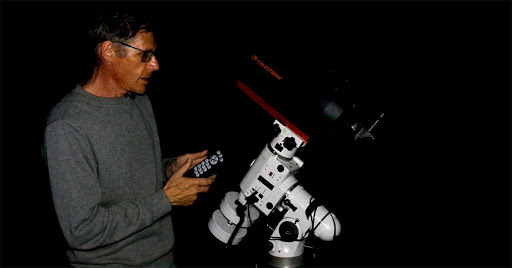Where on earth is Procyon? Sky alignments for your go-to mount
Go-to mounts are great
Many of our Sky-Watcher or saxon telescopes come on computerised mounts. These are great, and allow you to quickly find stars, planets and other targets without having to slog your way through star maps.
But they need to be aligned
For go-to slewing to work, you have to align the mount to the sky when you set up the scope.
Sky alignment allows your mount to know which way it is pointing. Telescopes, like planes and boats, change directions in three ways: pitch (up and down), roll (twisting clockwise or anticlockwise) and yaw (left and right).
Roll, for an alt-azimuth mount, such as a Sky-Watcher Star Discovery or a saxon AstroSeeker, really isn't much of a problem. This is because your mount should be close to level, and you're not going to move it anyway. To set pitch (known in astronomy as altitude) and yaw (known as azimuth), though, you're going to have to show it some stars before it can take over.
There are a number of different types of alignment you can do, each with a varying level of accuracy.
One-star
A one-star (or solar system) alignment will give you reasonable accuracy - enough for tracking the object you've originally aligned on. But move to a second star and you're likely to be hunting for a while. A one-star alignment assumes your scope is level, and needs your time and location to be pretty accurate.
Two-star
A two-star alignment will give better accuracy, certainly for targets not far from your alignment stars. It can get a good handle on what pitch and yaw settings it's going to need.
Three-star
But in order to get the best accuracy you're going to need a three-star alignment. After this, the mount knows where all the stars are. It can even figure out how out-of-level the mount is and can compensate for that as well. This is the alignment you really want.
But how do you align them?
 But now is tricky bit. Regardless of what type of alignment you're doing, the software now asks you which stars you’re going to align on. What happens when don’t know their names? Look at me in the photo at the top - I'm thinking "where on earth is Procyon?"
But now is tricky bit. Regardless of what type of alignment you're doing, the software now asks you which stars you’re going to align on. What happens when don’t know their names? Look at me in the photo at the top - I'm thinking "where on earth is Procyon?"
There you are, in the dark with your scope, trying to do a 2 or 3 star alignment, and your mount asks you to point it to, I don’t know, Miaplacidus or something. Most people (myself included) don’t know the names of many stars, so find this a bit intimidating.
There are three basic strategies.
Learn the names of stars
First, for traditionalists, you can learn the stars. Normally, software will suggest alignment stars from the brighter ones you can see at the time. To learn the stars, use a map (which is the third method). Jim's Cosmos (a useful suite of pages) includes a map that has alignment stars marked. People at the next ASV star party will be impressed!
Theres's an app for that
Second, use an app or a website to identify "on the fly" which stars the is suggesting. We all have different preferences, but I like Stellarium. The smart device app costs about $10. If you're after a free alternative, try StarWalk2. If the mount wants you to choose Miaplacidus as an alignment star, you can use Stellarium or StarWalk2 to figure out which actual star that is, so you can then point the telescope at it for the alignment.
Consult a map
Third, you can consult a star map. Try the one on the Heavens Above webpage.
This one is more specific than the one at Jim's Cosmos, in that you set your location, date and time. It then knows what the sky looks like from where you are. Make sure you tick the “star names” box. This will show you most of the stars you will need. Alternatively, you can get rather aesthetic set of paper charts at actual shops or the Internet.
These ones were given to me by a Slovak astronomer when I visited the observatory in (what was then) Czechoslovakia in 1987. Apart from being consulted occasionally, they make great art.
Of course, If you want to go seriously old-school, I’ve got a Norton’s Star Atlas from about 1975 you can borrow – heavily annotated, mind you. So much for that "without having to slog your way through star maps" comment!




Comments
Post a Comment